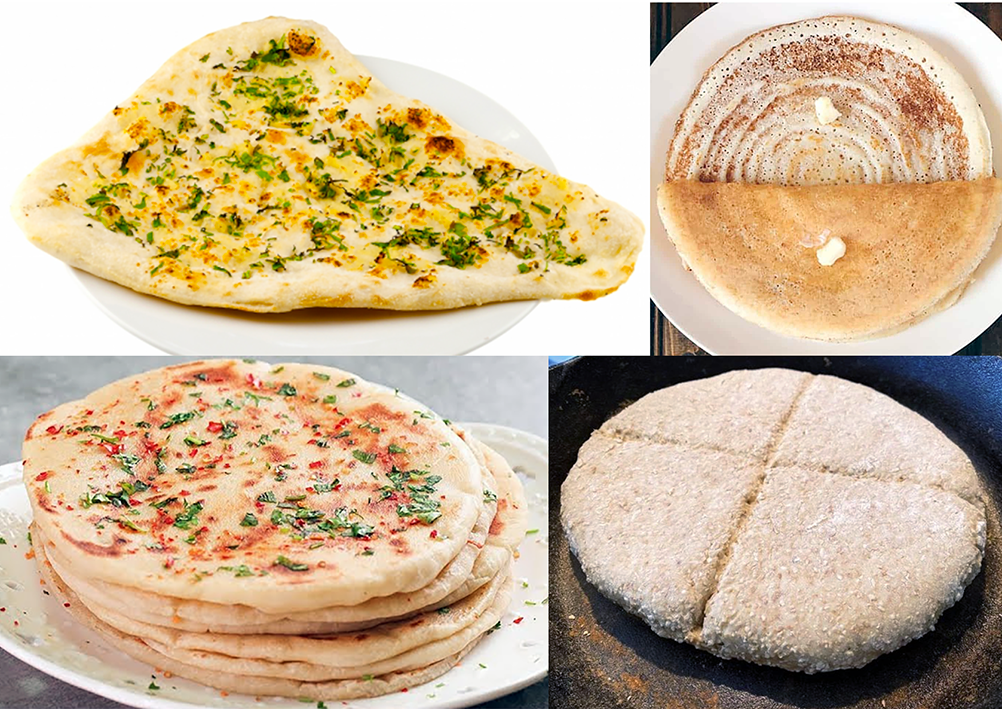FabulousFusionFood's Flatbread Recipes 2nd Page
 Examples of Flatbreads, clockwise from top left: Indian naan, Indian
Examples of Flatbreads, clockwise from top left: Indian naan, Indiandosa, Scottish bannock, Turkish pita.
Welcome to FabulousFusionFood's Flatbread Recipes Page — A flatbread is bread made usually with flour; water, milk, yogurt, or other liquid; and salt, and then rolled or patted into flattened dough. Many flatbreads are unleavened, although some are leavened, such as pita bread or naan breads. It's likely that flatbreads pre-date agriculture and would have been produced by hunter gatherers from whatever grains or nuts were available. After grinding or pounding they only require water to bind and a hot rock on which to cook them.
Flatbreads were amongst the earliest processed foods, and evidence of their production has been found at ancient sites in Mesopotamia, ancient Egypt, and the Indus civilization. The origin of all flatbread baking systems are said to be from the Fertile Crescent in West Asia, where they would subsequently spread to other regions of the world.
In 2018, charred bread crumbs were found at a Natufian site called Shubayqa 1 in Jordan (in Harrat ash Shaam, the Black Desert) dating to 12,400 BC, some 4,000 years before the start of agriculture in the region. Analysis showed that they were probably from flatbread containing wild barley, einkorn wheat, oats, and Bolboschoenus glaucous tubers (a kind of rush).
Our first literary information about breakfast comes from Ancient Egypt, where peasants ate a daily meal, most likely in the morning, consisting of soup, beer, bread, and onions before they left for work in the fields or work commanded by the pharaohs. The traditional breakfast believed to have been cooked in ancient Egypt was fūl (made from broad [fava] beans, possibly the antecedent of today's ful medames), baladi bread, made from emmer wheat, and falafel, a mixture of broad beans with onions, garlic, parsley and coriander.
Primitive clay ovens (tandir) used to bake unleavened flatbread were common in Anatolia during the Seljuk and Ottoman eras, and have been found at archaeological sites distributed across the Middle East. The word tandır comes from the Akkadian tinuru, which becomes tannur in Hebrew and Arabic, tandır in Turkish, and tandur in Urdu/Hindi. Of the hundreds of bread varieties known from cuneiform sources, unleavened tinuru bread was made by adhering bread to the side walls of a heated cylindrical oven. This type of bread is still central to rural food culture in this part of the world, reflected by the local folklore, where a young man and woman sharing fresh tandır bread is a symbol of young love, however, the culture of traditional bread baking is changing with younger generations, especially with those who reside in towns showing preference for modern conveniences.
Flatbreads have been and are made by pretty much every culture on earth, with recipes ranging from Algerian Aghroum through Turkish Yufka. The advent of baking soda in the late 19th Century means that many flatbreads can now be chemically leavened (such as Scottish bannock). Across the globe, literally hundreds of flabreads are cooked and they are not just made from grains. Anything with a high starch content, or which can be ground and rendered into flour can be made into a flatbread.
In the European Middle Ages, breakfast was commonly eaten by working people, as well as children, the elderly, the sick, while the upper classes didn't speak of or partake in eating in the morning. Eating breakfast meant that one was poor, was a low-status farmer or laborer who truly needed the energy to sustain his morning's labor, or was too weak to make it to the large, midday dinner. Monarchs and their entourages would spend a lot of time around a table for meals. Only two formal meals were eaten per day—one at mid-day and one in the evening. The exact times varied by period and region, but this two-meal system remained consistent throughout the Middle Ages. In the 13th century, breakfast when eaten sometimes consisted of a piece of rye bread and a bit of cheese. Morning meals would not include any meat, and would likely include 0.4 imperial gallons (1.8l) of low alcohol-content beers. Uncertain quantities of bread and ale could have been consumed in between meals.
After Turkish/Greek pita/pitta breads, probably the most well known flatbreads originate in India and include: parathas, bhakri, chapati, dosa, roti, parotta, puri, kachori and and naan, amongst many others. Many flatbreads are also stuffed with fillings like beans and potatoes, with the filling being cooked, cooled then incorporated in the bread so it acts as a filing which then heats up as the bread cooks. Flatbreads are often served as accompaniments to stews, but they can be served for breakfasts, as snacks to accompany dips or even used as pizza bases. They also range in style from thin and pancake like (such as dosas or chapatis to much thicker and more bread-like in consistency [pitas, naan breads]).
The alphabetical list of all the breakfast recipes on this site follows, (limited to 100 recipes per page). There are 117 recipes in total:
Page 2 of 2
| Tandoori Roti Origin: India | Traditional Chapati Origin: Anglo-Indian | Virgin Island Roti Origin: British Virgin Islands |
| Teff Injeera Origin: Ethiopia | Trinidadian Roti Origin: Trinidad | Virgin Island Roti Origin: US Virgin Islands |
| Thepla Origin: India | Turks and Caicos Bammy Origin: Turks Caicos | Wholegrain Lachha Paratha Origin: India |
| Torta de gazpacho Manchego (Manchego Gazpacho Flatbreads) Origin: Spain | Ugandan Chapati Origin: Uganda | Yaniqueque (Johnny Cakes) Origin: Dominican Republic |
| Tortillas di Harina (Flour Tortillas) Origin: Mexico | Victorian Dal Puri Origin: Anglo-Indian | Zambian Chapati Origin: Zambia |
| Tortillas di Harina (Flour Tortillas) Origin: Honduras | Viking Flatbread Origin: Ancient |
Page 2 of 2